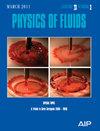锥形纤维上液滴的毛细管驱动迁移
IF 4.3
2区 工程技术
Q1 MECHANICS
引用次数: 0
摘要
由于毛细作用,亲水性锥形纤维上的液滴倾向于向较大半径的末端移动。实验研究探索了不同粘度和体积的液滴在不同纤维上的微观动态。研究发现,液滴在迁移过程中最初加速,随后减速。为捕捉液滴迁移的动态过程,建立了一个动态模型,以解决以往基于平衡的缩放定律的局限性。实验结果和理论预测都表明,在发散性更强的纤维上的液滴会经历更长的加速阶段。此外,在锥角较小的纤维上,重力效应非常明显,甚至在毛细尺度以下也会对液滴迁移产生重大影响。此外,与用相同液体预湿的纤维相比,液滴在干燥纤维上的移动速度更慢,这主要归因于摩擦力的增加。实验显示,液滴在干燥纤维上迁移后会形成一层残留液膜,导致液滴体积大量损失。为了涵盖干纤维上迁移的复杂性,对模型进行了改进,加入了更高的摩擦系数和可变液滴体积,从而更全面地描述了基本物理原理。本文章由计算机程序翻译,如有差异,请以英文原文为准。
Capillary-driven migration of droplets on conical fibers
A droplet placed on a hydrophilic conical fiber tends to move toward the end of larger radii due to capillary action. Experimental investigations are performed to explore the dynamics of droplets with varying viscosities and volumes on different fibers at the microscale. Droplets are found to accelerate initially and subsequently decelerate during migration. A dynamic model is developed to capture the dynamics of droplet migration, addressing the limitations of previous equilibrium-based scaling laws. Both experimental results and theoretical predictions indicate that droplets on more divergent fibers experience a longer acceleration phase. Additionally, gravitational effects are pronounced on fibers with small cone angles, exerting a substantial influence on droplet migration even below the capillary scale. Moreover, droplets move more slowly on dry fibers compared to those prewetted with the same liquid, primarily attributed to increased friction. The experiments reveal the formation of a residual liquid film after droplet migration on dry fibers, leading to considerable volume loss in the droplets. To encompass the intricacies of migration on dry fibers, the model is refined to incorporate a higher friction coefficient and variable droplet volumes, providing a more comprehensive depiction of the underlying physics.
求助全文
通过发布文献求助,成功后即可免费获取论文全文。
去求助
来源期刊

Physics of Fluids
物理-力学
CiteScore
6.50
自引率
41.30%
发文量
2063
审稿时长
2.6 months
期刊介绍:
Physics of Fluids (PoF) is a preeminent journal devoted to publishing original theoretical, computational, and experimental contributions to the understanding of the dynamics of gases, liquids, and complex or multiphase fluids. Topics published in PoF are diverse and reflect the most important subjects in fluid dynamics, including, but not limited to:
-Acoustics
-Aerospace and aeronautical flow
-Astrophysical flow
-Biofluid mechanics
-Cavitation and cavitating flows
-Combustion flows
-Complex fluids
-Compressible flow
-Computational fluid dynamics
-Contact lines
-Continuum mechanics
-Convection
-Cryogenic flow
-Droplets
-Electrical and magnetic effects in fluid flow
-Foam, bubble, and film mechanics
-Flow control
-Flow instability and transition
-Flow orientation and anisotropy
-Flows with other transport phenomena
-Flows with complex boundary conditions
-Flow visualization
-Fluid mechanics
-Fluid physical properties
-Fluid–structure interactions
-Free surface flows
-Geophysical flow
-Interfacial flow
-Knudsen flow
-Laminar flow
-Liquid crystals
-Mathematics of fluids
-Micro- and nanofluid mechanics
-Mixing
-Molecular theory
-Nanofluidics
-Particulate, multiphase, and granular flow
-Processing flows
-Relativistic fluid mechanics
-Rotating flows
-Shock wave phenomena
-Soft matter
-Stratified flows
-Supercritical fluids
-Superfluidity
-Thermodynamics of flow systems
-Transonic flow
-Turbulent flow
-Viscous and non-Newtonian flow
-Viscoelasticity
-Vortex dynamics
-Waves
 求助内容:
求助内容: 应助结果提醒方式:
应助结果提醒方式:


